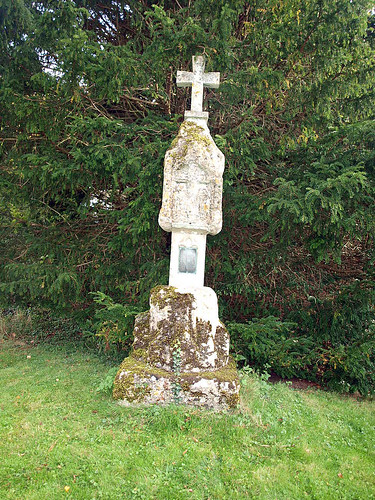ST JAMES. In the park, S of the manor house. Not a building of distinction. W tower with Perp doorway but upper windows of the C13. Aisle windows mostly C19. S doorway early C14, chancel N doorway also (with a very pronounced ogee head).Three-bay arcade of octagonal piers with double-chamfered arches. The chancel arch similar. - DOOR. In the tympanum some carved fragments, C18 and apparently Flemish or French. - SCULPTURE. Cross-head in the churchyard with Crucifixion, St Michael, and Saints; Perp. - MONUMENT. Edward Leeds d. 1589, Master of Clare Hall Cambridge from 1560 to 1571. Brass on a tomb-chest with belated baluster columns. Inscription-plate on the back wall, very classically framed. Framing architecture with Ionic columns and strapwork. The HELMET etc., on a window-sill on the N side belonged to this monument.
CROXTON. Thatched cottages and a timbered house almost invade the park, where a church hiding in the elms and a Georgian house have a delightful setting by the lake.
On the churchyard lawn is the medieval cross, shortened but still with its canopied head on which are fading away with time and weather figures of Christ on the Cross, Michael weighing a soul, Anthony with his pig, and a pilgrim with a staff. Old Stones make up the 20th century north porch, which is an astonishing patchwork of Norman pillars, medieval tracery, part of a stone coffin, and most of a 14th century doorway, all helping to shelter the treasure of this place- - an ancient studded door with a battlemented border round its arch, and fixed to its panels a beautiful relief of the scene at Bethlehem, with the ox and the ass standing behind Jesus and his mother, all so perfect that its centuries might be only years.
The church is mostly 15th century, with a font as old as itself and a piscina 200 years older. At each corner of the nave roof stands a white-robed angel with golden hair, odd painted figures, two with their wings missing. The benches where the village folk sat in Tudor days are strong still and their tracery little worn, and more old woodwork screens the side walls of the chancel. From among fragments of old glass look out angels and men, and among the pictures in the modern east window is Ely Cathedral.
The brass portrait of Edward Leeds on his canopied tomb shows this Elizabethan benefactor of Emmanuel College in his doctor’s robes, a man of peace whose tomb has been turned into a little armoury, for on it we found a steel cap and breastplate of Cromwell’s time with two helmets of later wars, one German, the other French.
On the churchyard lawn is the medieval cross, shortened but still with its canopied head on which are fading away with time and weather figures of Christ on the Cross, Michael weighing a soul, Anthony with his pig, and a pilgrim with a staff. Old Stones make up the 20th century north porch, which is an astonishing patchwork of Norman pillars, medieval tracery, part of a stone coffin, and most of a 14th century doorway, all helping to shelter the treasure of this place- - an ancient studded door with a battlemented border round its arch, and fixed to its panels a beautiful relief of the scene at Bethlehem, with the ox and the ass standing behind Jesus and his mother, all so perfect that its centuries might be only years.
The church is mostly 15th century, with a font as old as itself and a piscina 200 years older. At each corner of the nave roof stands a white-robed angel with golden hair, odd painted figures, two with their wings missing. The benches where the village folk sat in Tudor days are strong still and their tracery little worn, and more old woodwork screens the side walls of the chancel. From among fragments of old glass look out angels and men, and among the pictures in the modern east window is Ely Cathedral.
The brass portrait of Edward Leeds on his canopied tomb shows this Elizabethan benefactor of Emmanuel College in his doctor’s robes, a man of peace whose tomb has been turned into a little armoury, for on it we found a steel cap and breastplate of Cromwell’s time with two helmets of later wars, one German, the other French.

No comments:
Post a Comment